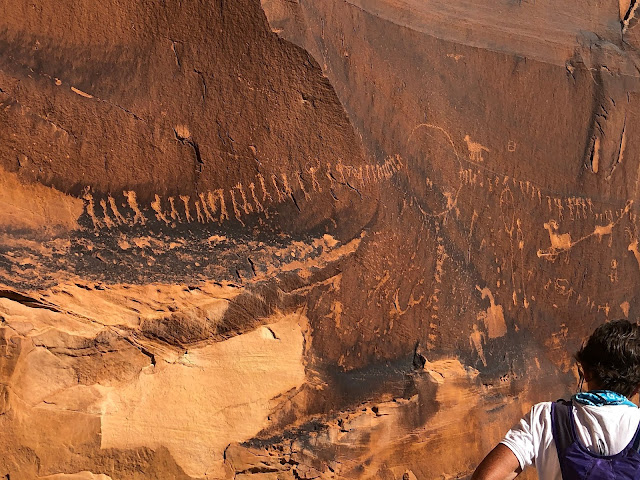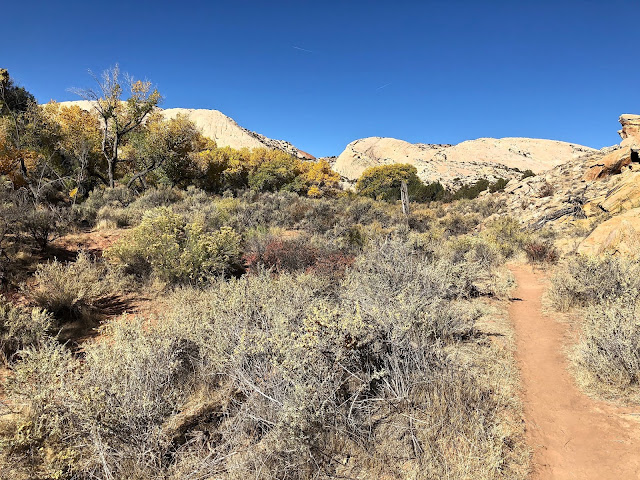It's difficult to fathom the incalculable amount of change that has taken place on planet earth since the industrial revolution, and, perhaps more importantly, the some-good/some-short sighted consequences there of. And to think, that a mere few hundred years prior to the I R, bands of semi-nomadic Native Americans were carving out an existence all around here, in the four corners region of the great Southwest. For the most, part they did it what the had...tools of stone, keen intellect, and a cooperative spirit, for a while anyway. Around the 13th century, "co-op" turned to war-hoops, and shit hit the fan. It's a lesson that shouldn't be lost on us today right here in the good ole USA. Cooperation, not division, is the key to Survival.
It's not like our Native American predecessors didn't have their fare share of differences. But they managed to resolve them with a crude, but effective, hierarchy-based form of governing that seemed to work...for a few centuries, anyway. Then we came along, imposed our religion and ways of life on the "heathens." Souls won for the Lord? No. It was more a decapitation of their very soul, which left them foundation-less and led to the collapse of their culture.
Having exhausted both ourselves and the likely possibility of other ruins within hiking distance of our mesa-top camp (to our limited knowledge, anyway), Bobbie and I, along with Pal Chris, took a day to drive backroads in search of other possible sites.
Turns out, they were not all that far away and not that hard to find. Just about any sizable drainage with south-facing cliffs, and water enough to support a stand of cottonwood trees at the mouth, is likely to yield evidence of lives lived as recently as 700 years ago to as far back as Before Christ. Of course reference books do help, but, trust me, the directions leave a lot to be desired. Perhaps the best way to find native antiquities is to drive valley floor backroads and look for parked cars. :)
Right off the bat, we were cast from air conditioned car, to the cool shade of cottonwoods, then onto brutal, reflective slabs of sandstone that amplified and reflected the sun's radiant heat. And this, with temps in the 80s. I couldn't imagine being out here in summer. The heat and sun were oppressive, but we had plenty of water and Gatorade, which, after a couple of hours, was warmed to a point of being only marginally palatable. Cue dreams of ice cream NOW.
 |
| Chris leaves no stone unexplored... |
 |
| And we finally reap the rewards of his patience and persistence. The stonework in this site was well done. |
 |
| We found lots of hand prints. |
 |
| Evidence of skilled masons abound |
 |
| 700 + year old pottery fragments and corncobs |
 |
| A promising alcove that resembles a "fish mouth"...Wonder if we can get up there? |
 |
| Water-carved potholes... |
On the way to "fish mouth," we spot another, much smaller alcove. While there was little to no construction evident, there were signs of use...perhaps as an art gallery?
 |
| Bear track petroglyph |
Then on to "fish mouth." It has a commanding view...hard to sneak up on.
Sadly, some people do things that are just plain stupid. Here is just a sampling of their modern-day handiwork...
We did find evidence of grinding stone grooves from corn being hand-milled, along with an assortment small cobs left behind.
 |
| Getting back down was tedious and kinda "snaky" on such a hot day. |
On the way out we found another somewhat hidden alcove. It had fine examples of construction and organizational skills. We tried to guess how many people inhabited this large site...perhaps an extended family?
 |
| Pottery shards... |
 |
| Same site, different direction... |
We had enough time to squeeze in another site, a place that showed little evidence of dwellings, but had an extensive and detailed panel of petroglyphs. Unfortunately, we arrived during the hottest part of the afternoon, and the route up to the panel was like a sandstone oven. Mmmm. Warm water and Gatorade...hardly refreshing.
The hike was beautiful, though, and quite dramatic. It helped take our minds off the heat and discomfort.
 |
| Bighorn sheep |
 |
| Marching men... Was it a warning to possible invaders of the presence of a large army? |
 |
| You can click on any photo to view them in a larger, more detailed format. |
 |
| Some of the "marching men" had arms raised in threatening gestures. |
It was a fine day of exploring in spite of brutal heat and sun. Dreams of my ice cold beer waiting back at camp made the drive home nearly intolerable.
Peace Out,
Mark, Bobbie, and Chris...on the trail and taking you along.
Next up: Hiking Natural Bridges..."the whole enchilada."


















Regarding the stonework room walls, what did they use to hold the stones (bricks) together? Did they have such a thing similar to cement back then?? And the bricks were cut stones?? Amazing handiwork for sure.
ReplyDeleteDon in Okla.
I think they used mud...and clay, when it was around. It does look like the stone was cut (chiseled), but there was plenty of stone around of all shapes and sizes and they might have just used ones that were squared off naturally. Just guessing, tho.
DeleteThe hike back to all the ruins at Fish Mouth are such fun. I'm glad to see that the corn cobs and pottery are still there. We did this three years ago. We combined it with the Monarch Ruins. No wonder you were exhausted. The Procession Panel is a good hike alone especially if you continue to climb to look all along the top of the comb. Butler Wash is just a treasure.
ReplyDeleteWOW! Triple wow! Your post is most appreciated today because I just finished a non-fiction book titled "Twelve by Twelve". Author William Powers discusses the old cultures and how the non-Westernized environments where people lived in harmony with each other and with nature have alot to teach us today. And your gorgeous photos drive it all home for me too.
ReplyDeleteExciting post for sure : so much for comfortable hiking weather, hate to think what it's going to be like in another 50 yrs.
ReplyDeleteD & A
Loving those pottery shard photos
ReplyDelete